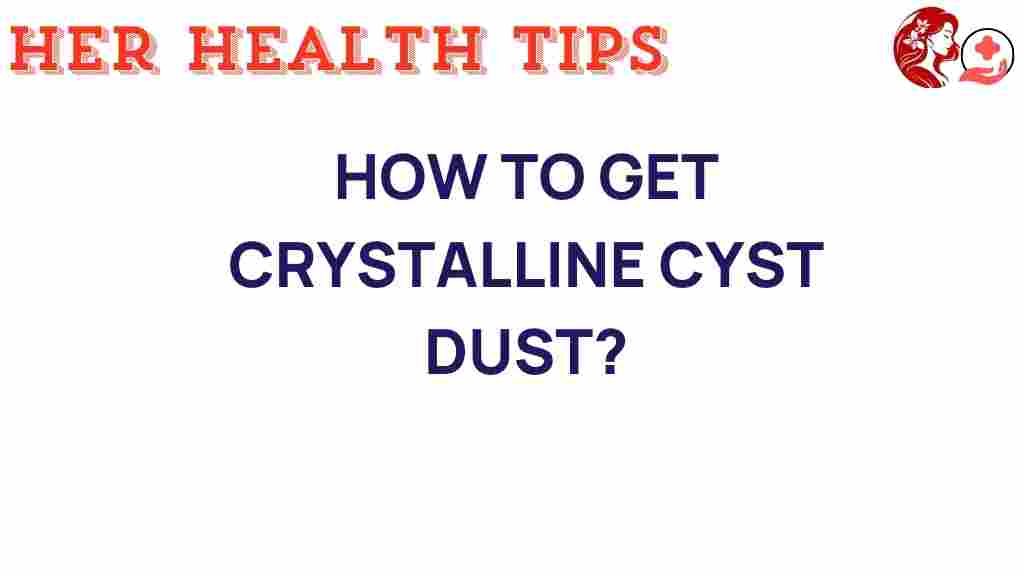Unveiling the Mysteries of Crystalline Cyst Dust: What You Need to Know
Crystalline cyst dust is a term that may raise eyebrows among many, but understanding its implications is crucial for health and wellness. This article aims to delve deep into the science behind crystalline cyst dust, exploring its symptoms, the conditions associated with it, potential treatments, and effective prevention strategies. Through recent research, we will shed light on this intriguing subject, providing you with all the essential information you need.
What is Crystalline Cyst Dust?
Crystalline cyst dust refers to fine particles that can accumulate from various sources, particularly in environments where cysts are present. These particles can arise from the breakdown of cysts in the body or from external sources that are contaminated. Understanding crystalline cyst dust is essential as it can be associated with specific health conditions.
The Science Behind Crystalline Cyst Dust
Crystalline cyst dust is primarily composed of crystalline structures formed during the breakdown of cysts. Cysts can develop in various tissues and organs, leading to the release of these particles into the surrounding environment. The study of crystalline materials falls under the umbrella of crystallography, a field that examines the arrangement of atoms in crystalline solids.
- Research Findings: Recent studies have highlighted the potential health impacts of exposure to crystalline cyst dust.
- Health Impact: Chronic exposure can lead to respiratory issues and other health complications.
Symptoms Associated with Crystalline Cyst Dust
Recognizing the symptoms related to exposure to crystalline cyst dust is crucial for early intervention. Common symptoms include:
- Difficulty breathing or shortness of breath
- Persistent cough
- Chest tightness or pain
- Fatigue and malaise
- Skin irritation or rashes
If you experience any of these symptoms, it is important to seek medical advice promptly.
Conditions Linked to Crystalline Cyst Dust
Several health conditions can be linked to exposure to crystalline cyst dust. These include:
- Respiratory Diseases: Prolonged exposure can lead to chronic respiratory conditions.
- Allergic Reactions: Some individuals may develop allergies or sensitivities to these particles.
- Autoimmune Conditions: In rare cases, exposure may trigger or exacerbate autoimmune responses.
At-Risk Populations
Certain groups may be more susceptible to the health effects of crystalline cyst dust, including:
- Individuals with pre-existing respiratory conditions
- Those working in dusty environments
- People with weakened immune systems
Treatment Options for Health Issues Related to Crystalline Cyst Dust
If you suspect that you have been exposed to crystalline cyst dust and are experiencing symptoms, several treatment options may help alleviate your condition:
- Medical Evaluation: Consult a healthcare professional for proper diagnosis and treatment.
- Medications: Anti-inflammatory medications and bronchodilators may be prescribed to manage symptoms.
- Environmental Control: Reducing exposure to crystalline cyst dust in your living and working environment is crucial.
- Respiratory Therapy: In severe cases, therapies may be recommended to improve lung function.
Preventing Exposure to Crystalline Cyst Dust
Prevention is key when it comes to minimizing the risks associated with crystalline cyst dust. Here are some effective strategies:
- Maintain Clean Environments: Regular cleaning can help reduce dust accumulation.
- Use Protective Gear: Wearing masks and protective clothing in dusty environments can protect against inhalation.
- Improve Ventilation: Ensure proper ventilation in areas where dust may accumulate.
- Monitor Air Quality: Use air purifiers and monitor indoor air quality to reduce dust levels.
Research on Crystalline Cyst Dust
Ongoing research is essential to fully understand the implications of crystalline cyst dust on health. Studies are focusing on:
- Identifying the primary sources of crystalline cyst dust
- Understanding the biological mechanisms of exposure
- Developing effective treatment protocols
For more detailed information on the latest findings, you can refer to this research article.
Troubleshooting Tips for Managing Symptoms
If you are experiencing symptoms related to crystalline cyst dust, here are some troubleshooting tips:
- Stay Hydrated: Drinking plenty of water can help thin mucus and ease breathing.
- Avoid Irritants: Stay away from smoke, strong odors, and other respiratory irritants.
- Monitor Symptoms: Keep track of your symptoms and seek medical assistance if they worsen.
Conclusion
Understanding crystalline cyst dust is essential for maintaining health and wellness. By recognizing symptoms, understanding associated conditions, and employing effective prevention and treatment strategies, you can protect yourself from potential health risks. Ongoing research continues to unveil the mysteries surrounding crystalline cyst dust, paving the way for better health outcomes. For further reading on health topics, visit our health and wellness page.
Remember, staying informed and proactive about your health is the best approach to wellness!
This article is in the category Conditions and created by HerHealthTips Team
